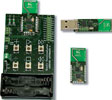

Traditional infrared (IR) remote controls use IR LEDs to emit radiation focused by a plastic lens into a narrow beam.
Data is encoded by modulating the beam to provide immunity from other IR sources such as fluorescent lights. The receiver uses a silicon photodiode to convert the IR radiation to a current for decoding by the receiver's MCU. IR does not penetrate walls - although it can be reflected by walls and ceilings - and so generally does not interfere with other devices in adjoining rooms.
However, while IR's simplicity, low-cost and low-power consumption has ensured its widespread adoption, the technology is not without its weaknesses. The requirement for line-of-sight (or at least direct reflection), limited range and the complexity involved in accommodating bidirectional communications are the three major drawbacks.
RF (radio frequency) technology addresses all of these challenges: it does not require line-of-sight communication; can control appliances from room-to-room at ranges up to 10 metres, and easily supports two-way transmission.
The RF alternative
RF has been an option for remote control for some time but the technology's relative expense, design complexity and power consumption have made it uncompetitive with IR for most applications. Nordic Semiconductor claims that the development of a new generation of low power RF transceivers such as the nRF24L01, however, is helping to change that.
That said, the hardware is only part of the solution; a robust RF protocol is crucial to produce an RF link that works well in the presence of other RF systems utilising the ever more crowded 2,4 GHz band. Consequently, a good RF solution not only depends on competent hardware design, but also demands a good knowledge of wireless protocol design.
RF remote design made easy
To ease the design process, Nordic Semiconductor offers an RF remote control reference design, the nRD24H1. The device (transmitter) side of the nRD24H1 is implemented as a hardware module fitted on a six-button controller application board. The module includes a PCB antenna, 2,4 GHz transceiver (nRF24L01) and 8-bit MCU. The RF module supports up to 49 button inputs plus status LEDs. An alternative layout has fewer input buttons combined with serial interfaces for display support.
The reference design's host (receiver) is a production ready, full-speed USB dongle supporting the HID (human interface device) class with descriptors for all commands defined in Windows Vista. A USB compliance certificate is included in the kit, as well as a test ID for USB. This means that if changes to the supplied USB module are limited, USB compliance can be obtained simply by referring to this design.
The nRD24H1 also includes all firmware needed to make a remote control. The key part of this firmware is a complete two-way RF protocol stack for remote control applications. The protocol stack is implemented as a standalone software module providing an API (application programming interface) to the application layer. On top of this protocol stack, a simple application layer example, specific to the six button application board, is also included.
| Tel: | +27 21 555 8400 |
| Email: | [email protected] |
| www: | www.rfdesign.co.za |
| Articles: | More information and articles about RF Design |

© Technews Publishing (Pty) Ltd | All Rights Reserved